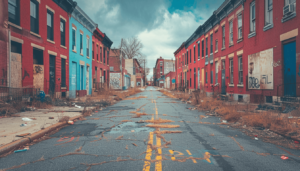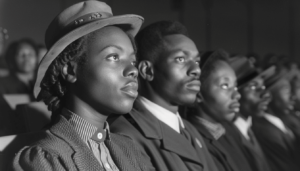Across the United States, urban renewal policies bulldozed more than buildings—they dismantled Black prosperity. From the 1940s through the 1970s, federal planning and infrastructure projects targeted neighborhoods where Black-owned businesses, civic institutions, and cultural life had built generational wealth. These corridors—often called Black Wall Streets—were engines of economic power and community resilience.
The Greenwood District in Tulsa, widely known as the original Black Wall Street, offers a stark example. After surviving the 1921 massacre, the community rebuilt—only to be fractured again by highway construction decades later. Similar patterns unfolded in cities like Detroit, Newark, and Philadelphia, where labels like “blight” and tools like rezoning and eminent domain redirected land and capital away from Black families.
These historical choices continue to shape modern disparities in lending, venture capital, and household wealth. For data-driven context, see Brookings’ analysis of the racial wealth gap.
Key Takeaways
- Policy choices reshaped land use and eroded local business networks.
- Historic case studies show how infrastructure siting fragmented commercial corridors.
- Today’s wealth gap and credit barriers reflect long-term effects of those actions.
- Business closures and denied loans limited intergenerational wealth building.
- Analyzing past mechanisms helps frame policy paths for rebuilding ownership and access.
🧭 Displacing Black Wall Streets: Infrastructure Policy, Urban Renewal, and Generational Wealth Loss
Throughout the 20th century, a combination of urban planning, infrastructure siting, and racial violence fragmented local economies built by Black entrepreneurs. This overview outlines how those decisions—especially those tied to urban renewal—continue to shape disparities in wealth, property ownership, and business density today.
The scope spans major historic Black Wall Streets, including Tulsa’s Greenwood District, Detroit’s Paradise Valley, and Philadelphia’s Black Bottom. It examines the tools used against them—such as highway construction, eminent domain, and rezoning—and draws from long-run data on credit access, property values, and entrepreneurial ecosystems.
For a deeper look at how infrastructure decisions displaced Black communities and benefited institutions, see New America’s analysis.
🏙️ Urban Renewal’s Lasting Damage: How Federal Infrastructure Fractured Black Business Districts
Tulsa’s Greenwood District was once described as “beautiful, bustling, and Black.” After the 1921 Tulsa Race Massacre, Greenwood rebuilt with remarkable resilience. But mid-century federal policies and the routing of Interstate 244 led to a second wave of destruction—fracturing businesses, institutions, and generational wealth.
Similar patterns unfolded in:
- Detroit’s Paradise Valley
- Philadelphia’s Black Bottom
- Newark’s High Street
These cases show how urban renewal wasn’t just about infrastructure—it was about redirecting land and capital away from Black communities.
📊 Tracing Displacement: Historical Evidence and Comparative Data on Black-Owned Business Corridors
This analysis draws from:
- Archival records and city planning documents
- Infrastructure timelines and highway routing maps
- Modern datasets on business ownership, credit access, and household wealth
By comparing multiple Black business districts, the report identifies recurring patterns of policy-driven displacement, while also highlighting local variations in resistance, recovery, and preservation.
For a broader view of how these patterns shaped outcomes, see Eliminating the Wealth Gap.
🔍 What the Data Reveals: Patterns of Displacement and Pathways to Black Economic Restoration
- Urban renewal reduced Black business density and property wealth across multiple cities.
- Today’s disparities in capital and ownership trace directly to mid-century planning layered on earlier violence.
- Community-led preservation and entrepreneurship efforts offer partial recovery pathways—but require sustained investment and policy support.
Urban Renewal in Practice: How Policies, Timelines, and Infrastructure Tools Displaced Black Wall Streets
Urban renewal refers to a set of federal and local measures—beginning with the Housing Act of 1949—that enabled cities to reshape land use through redevelopment, slum clearance, and highway construction. These interventions combined federal funding, technical guidance, and legal instruments that cities used to declare land for clearance and reassembly—often targeting Black business districts.

🛣️ Federal Urban Renewal: From the Housing Act of 1949 to Highway Displacement of Black Wall Streets
The Housing Act of 1949 created federally backed slum clearance funds, allowing cities to purchase and demolish properties under the guise of “renewal.” Later, interstate highway programs routed roads directly through established commercial corridors—displacing businesses, residents, and institutions.
Examples include:
These routes fractured economic ecosystems and erased decades of Black prosperity.
⚠️ How Blight Metrics and Slum Clearance Targeted Black Business Districts
Officials often used vague and subjective blight metrics to justify clearance. These measures reflected local preferences—and frequently racial bias—concentrating pressure where downtown land value and segregation patterns overlapped.
In Philadelphia’s Black Bottom, “blight” designations paved the way for institutional expansion at the expense of community ownership. Similar tactics were used in Boston’s Roxbury, where redlining and renewal worked in tandem to suppress Black property wealth.
🧱 Freeway Siting and Eminent Domain: Tools That Dismantled Black Wall Streets
Tools like eminent domain, land assembly, and public-private partnerships transferred valuable parcels away from legacy owners. The physical placement of infrastructure severed customer flows, weakened institutions, and reduced business creditworthiness.
“Cities and redevelopment agencies acted as intermediaries, channeling federal funds into projects that often prioritized new uses over existing community ownership.”
Key mechanisms:
- Federal grants
- Eminent domain
- Zoning changes
- Public-private redevelopment deals
Consequences:
- Lost storefronts
- Lower foot traffic
- Fractured local economies
For more on how these patterns unfolded in other cities, see:
🔥 How Black Wall Streets Thrived Before Urban Renewal: Entrepreneurship, Finance, and Community Power Under Segregation
Before mid-century policy shifts and urban renewal programs, Black commercial corridors flourished through decades of adaptive enterprise, mutual support, and community-led finance. These districts—later known as Black Wall Streets—were built under the weight of Jim Crow laws, Black Codes, and systemic exclusion. Yet despite legal barriers, Black entrepreneurs created durable markets anchored by churches, schools, and fraternal organizations.
For examples of how these ecosystems thrived before displacement, see:
🛠️ Black Entrepreneurship Under Jim Crow: Innovation, Demand Concentration, and Community-Led Growth
Segregation limited market access—but it also concentrated demand within Black neighborhoods. This pressure drove entrepreneurship in trades, retail, and professional services. Black business owners responded with innovation, resilience, and community-centered growth.
At the turn of the 20th century, directories and census records documented rapid expansion. The Negro Year Book (1914–1915) recorded:
- Over 40,000 Black-owned enterprises by 1913
- More than 500,000 Black-owned homes
These figures reflect real wealth formation and economic agency—despite exclusion from mainstream credit and commercial networks.
For comparative growth patterns, see San Francisco’s Fillmore District, where Black entrepreneurship surged before freeway construction.
💰 Building Black Wealth: Cooperative Finance, Mutual Aid, and Community Banking Before Integration
Local institutions played a critical role in stabilizing commerce and pooling capital. From the Grand Fountain United Order of True Reformers to St. Luke Penny Savings Bank, Black communities built financial systems that underwrote expansion and reduced risk.
Key dynamics:
- Concentration: Proximity to churches, schools, and fraternal groups created dense market networks
- Self-reliance: Mutual insurance and savings banks filled gaps left by exclusion from mainstream finance
- Resilience: Cooperative governance and shared tools reinforced local economic activity
“These institutions turned segregation into a focal point for specialized services and community wealth.”
For modern echoes of these models, see The Modern Black Wall Streets Emerging Across the U.S., which explores how cooperative finance and legacy preservation continue today.

🏙️ Tulsa’s Greenwood District: Black Wall Street’s Rise, Destruction, and Urban Renewal Displacement
Tulsa’s Greenwood District—widely known as Black Wall Street—emerged in the early 1900s as a concentrated commercial hub where Black entrepreneurs built a thriving local economy. Before federal infrastructure projects and racial violence disrupted its trajectory, Greenwood stood as a national symbol of Black prosperity, self-reliance, and community wealth.
For a deeper look at Greenwood’s legacy, see Tulsa’s Greenwood District: The Original Black Wall Street.
🌟 “Beautiful, Bustling, and Black”: Greenwood’s Early Growth
By the 1910s, Greenwood hosted more than 100 Black-owned businesses, including banks, hotels, theaters, and retail shops. Its streets supported a robust local economy and civic institutions—anchored by churches, schools, and fraternal organizations—that fostered intergenerational stability.
This concentrated prosperity made Greenwood one of the most economically vibrant Black communities in the country, rivaling Sweet Auburn Avenue in Atlanta and Central Avenue in Los Angeles.
🔥 The 1921 Tulsa Race Massacre and Greenwood’s Rapid Rebuilding
On May 31–June 1, 1921, white mobs attacked Greenwood, leveling 35 blocks, injuring more than 800 residents, and killing an estimated 100–300 people. The massacre destroyed homes, businesses, and civic infrastructure—reshaping property ownership and economic mobility for generations.
Despite this devastation, Greenwood residents rebuilt quickly. By the 1940s, the district had regained much of its vitality, once again becoming a regional center for Black business and cultural life.
For survivor accounts and archival context, see Tulsa Historical Society’s Massacre Resources and Greenwood Cultural Center.
🚧 Urban Renewal and the I-244 Cut-Through: Greenwood’s Second Displacement
In the 1960s and 1970s, federal infrastructure policy delivered a second blow. The construction of Interstate 244 bisected Greenwood, removing homes and storefronts, fragmenting customer flows, and suppressing recovery for remaining businesses.
This phase of urban renewal—driven by highway siting and land clearance—compounded earlier harms. Greenwood’s economic footprint shrank, and foot traffic declined as physical barriers disrupted community cohesion.
For comparative cases, see:
⚖️ Legal Headwinds and Unresolved Calls for Redress
In 2024, a court ruling denied reparations to the last known survivors of the massacre, leaving many calls for justice unresolved. The decision underscored how policy violence—from racial terror to infrastructure siting—continues to shape outcomes for Black communities.
For analysis of the ruling and its implications, see NPR’s coverage of the 2024 Tulsa reparations case.
For analysis of long-term costs and contemporary rebuilding efforts, see the true costs of the Tulsa and perspectives on building Black-owned businesses then and now.
🚧 How Urban Renewal Displaced Black Wall Streets and Erased Historic Black Business Districts
Three mid-century corridors—Hayti in Durham, Indiana Avenue in Indianapolis, and Central Avenue in Los Angeles—reveal a recurring pattern: freeway construction, slum clearance, and redevelopment plans removed homes, storefronts, and civic institutions that once sustained dense Black commercial ecosystems. These projects fractured community cohesion and redirected capital away from legacy ownership.

🛣️ Hayti, Durham: How NC 147 Displaced a Thriving Black Wall Street
The construction of NC 147 cut through Durham’s Hayti District, displacing thousands of residents and severing customer flows that supported nearby businesses. Churches, clubs, and cultural anchors were lost, and storefront density declined sharply.
For a full case study, visit Hayti, Durham: How Highways Erased a Black Wall Street.
🎶 Indiana Avenue, Indianapolis: I-65’s Role in Erasing a Black Business District
I-65 bisected Indiana Avenue, removing iconic music venues and dozens of Black-owned businesses. The disruption reduced foot traffic and weakened the corridor’s cultural draw.
Local organizations have since worked to preserve memories and revive parts of the district. See Indiana Avenue: The Greenwood of the Midwest for more.
🎷 Central Avenue, Los Angeles: How Urban Renewal Displaced a Historic Black Wall Street
Central Avenue faced displacement from freeway routing and redevelopment plans that prioritized regional mobility over neighborhood continuity. The result was cultural fragmentation and economic decline.
Today, events like the Central Avenue Jazz Festival and institutions such as the Hayti Heritage Center lead preservation efforts and advocate for equitable rebuilding. Learn more at Central Avenue: A Forgotten Black Wall Street.
📉 Shared Impacts: How Infrastructure Projects Fragmented Black Commerce and Community Cohesion
- Infrastructure routing rerouted customers, fragmented communities, and depressed business sales.
- Cities prioritized regional traffic over district continuity, reducing hub density and weakening local economies.
🔁 Rebuilding Black Wall Streets: Restoration Through Ownership, Connectivity, and Preservation
The path forward includes:
- Reconnecting fractured corridors
- Supporting resident ownership and cooperative finance
- Learning from case studies to rebuild historic economic centers
Explore additional examples:
⚠️ Mechanisms of Black Wealth Loss: Racial Violence, Urban Renewal Policy, and Bureaucratic Displacement
Across the 20th century, a combination of racial violence, urban renewal, and bureaucratic exclusion reshaped commerce and ownership in Black communities. A single episode of destruction—whether a riot, massacre, or clearance project—often triggered a long chain of legal and financial barriers that made recovery nearly impossible for residents and institutions.
For a broader overview, see How Urban Renewal Displaced Black Wall Streets.
🔥 Racial Violence and the Red Summer: Immediate Loss of Life, Property, and Stability
In 1919 alone, more than 25 major race riots erupted across the U.S., including attacks in Chicago, Washington D.C., and Elaine, Arkansas. The following year, 61 recorded lynchings further destabilized Black communities.
These events caused:
- Immediate destruction of homes and businesses
- Loss of life and generational trauma
- Chilled investment and interrupted local economic activity
Entrepreneurs fled, and community cohesion fractured. For context on Greenwood’s experience, see Tulsa’s Greenwood District: The Original Black Wall Street.
🧾 Bureaucratic Violence: Licensing, Zoning, and Professional Exclusion
Beyond physical attacks, administrative exclusion acted as a slow-burning assault on Black enterprise. Common tactics included:
- Licensing denials and permit delays
- Biased procurement and code enforcement
- Zoning restrictions under segregation
These tools constrained where businesses could operate and how they could scale. In Boston’s Roxbury, zoning and code enforcement suppressed commercial expansion while favoring institutional growth.
🏦 Redlining, Credit Denial, and Intergenerational Wealth Disruption
Redlining, loan discrimination, and insurance denial blocked access to capital for Black homeowners and entrepreneurs. Financial institutions enforced rules that kept investment out of targeted districts—undercutting property repair, business expansion, and generational wealth formation.
“Destruction without follow-up support left many districts trapped under layers of administrative barriers.”
These mechanisms:
- Narrowed the pipeline of new firms
- Reduced economic activity in Black business districts
- Created long-term gaps in ownership and wealth
For data-driven analysis, see The Modern Black Wall Streets Emerging Across the U.S. and Philadelphia’s Black Bottom, where redlining and renewal worked in tandem.

📊 Data on Black Wealth Gaps: Ownership, Capital Access, and Long-Term Displacement Trends
Since the 1970s, national data has traced a widening racial wealth gap—linking historic disinvestment to present-day shortages in capital, credit, and ownership. These disparities reflect how policy, infrastructure, and financial exclusion continue to shape outcomes for Black communities and legacy business corridors.
For foundational context, see Eliminating The Black-White Wealth Gap.
📉 Tracking the Racial Wealth Gap: How Black Families Lost Ground Since the 1970s
According to the ACLU’s 2023 report, the racial wealth gap has widened significantly. In 2018, a typical white family of three had approximately $33,000 more in annual resources than a comparable Black family.
This persistent shortfall:
- Reduces household savings
- Limits resilience during economic shocks
- Constrains investment in business formation and growth
For historical context, see Revisiting Red Summer.
🏠 Black Homeownership and Business Ownership: How Collateral Gaps Suppress Growth in Legacy Corridors
Homeownership remains a primary lever for wealth creation. Yet Black homeownership has not exceeded 50% in the past decade, limiting access to collateral for business loans and suppressing intergenerational wealth.
Lower home equity leads to:
- Fewer start-ups
- Slower small-business growth
- Reduced stability in legacy commercial corridors
For strategies to support entrepreneurs, see How to Support Black Entrepreneurs.
💸 Credit Denial and VC Disparities: Why Black-Owned Firms Struggle to Scale
Recent data highlights stark disparities in access to credit and venture funding:
- The Federal Reserve’s SBCS 2022 shows Black-owned firms are twice as likely to be denied loans.
- The Annual Business Survey (ABS) 2022 found only 38.4% of Black-owned businesses received full funding, compared to 62.3% of white-owned firms.
- Venture capital for Black founders dropped from nearly $5B in 2021 to just $661M in 2023—only 0.48% of total VC funding. In Atlanta, funding fell from $467M to $23M over the same period.
| Measure | Key Figure | Consequence |
| Median Wealth Gap (2018) | $33,000 | Lower household buffers and less startup capital |
| Full Loan Funding (Black Firms) | 38.4% | Higher denial rates, constrained expansion |
| VC to Black Founders (2023) | $661M (0.48%) | Weak startup pipelines in key cities |
“Credit and capital flows shape which firms survive and which neighborhoods recover.”
🔁 Restoring Black Wealth: Data-Driven Priorities for Ownership and Capital Equity
The data ties institutions and policies to real-world consequences. Cities that expand inclusive finance tools, support resident ownership, and invest in legacy corridors can restore growth paths for Black-owned businesses and communities.
For coverage of modern recovery efforts, see:
- Beyond Tulsa: Modern Black Wall Streets Emerging Across the U.S.
- Houston’s Third Ward
- San Francisco’s Fillmore District
🛠️ Preserving Black Wall Streets: Cultural Memory, Economic Resilience, and Modern Recovery Hubs
Across the country, communities are preserving the legacy of Black Wall Streets while rebuilding commerce through people-centered initiatives. From cultural festivals to entrepreneurship pipelines, these efforts restore economic vitality and keep historical memory alive in legacy corridors.
For a broader view of how preservation intersects with recovery, see Modern Black Wall Streets Emerging Across the U.S..
🏛️ Cultural Anchors: Heritage Centers, Historic Designations, and Festival-Driven Commerce
Institutions like the Hayti Heritage Center and events such as the Central Avenue Jazz Festival demonstrate how cultural programming boosts foot traffic, vendor income, and civic pride.
These organizations:
- Combine preservation with event-driven commerce
- Strengthen community ties through storytelling and shared space
- Anchor legacy corridors with cultural continuity
Explore Central Avenue’s legacy and Hayti’s recovery efforts for deeper context.
🛍️ Buying Black at Scale: Marketplaces, Directories, and Network Effects in Legacy Corridors
Modern marketplaces and platforms scale economic impact through intentional spending and networked support:
- The Village Market generated $8.8M in direct sales and deployed $800K in grants to Black business owners.
- Platforms like Official Black Wall Street and The Gathering Spot expand buying networks and professional connections.
These ecosystems:
- Circulate dollars locally
- Build trust through visibility and shared values
- Reinforce legacy corridors with scalable infrastructure
For more on cooperative finance and modern recovery, see How to Support Black Entrepreneurs.
🎓 Education and Entrepreneurship: HBCU Pipelines and Capital-Ready Black Founders
Institutions like the Center for Black Entrepreneurship at the Atlanta University Center are building capital-ready founders through training, mentorship, and procurement links. Backed by $10M from Bank of America, the center connects students to real-world markets with stronger social capital and technical support.
Education-driven models:
- Produce resilient entrepreneurs
- Embed legacy into business formation
- Expand access to capital and procurement pathways
For more on education’s role in legacy preservation, see Atlanta’s Sweet Auburn Avenue.
📈 Impact Snapshot: Cultural, Commercial, and Educational Initiatives Driving Black Economic Restoration
| Initiative | Type | Measured Outcome |
| Hayti Heritage Center | Cultural Preservation | Increased festival attendance; vendor sales growth |
| The Village Market (Atlanta) | Marketplace & Grants | $8.8M sales; $800K grants |
| Center for Black Entrepreneurship | Education & Capital | $10M secured; mentorship programs |
“Sustained programming, paired with grants and networks, rebuilds trust and circulates dollars in local communities.”
🔁 Restoring Legacy Corridors: Coordinated Strategies for Ownership, Trust, and Long-Term Growth
Preservation is not passive—it’s a coordinated effort across cultural organizations, marketplaces, and education pipelines. When backed by policy and philanthropy, these strategies help sustain long-term growth for Black communities and rebuild the economic foundations of historic Black Wall Streets.
🧭 Equitable Revitalization Strategies: Policy Tools and Community-Led Pathways to Restore Black Wall Streets
A legacy-driven roadmap turns evidence into action—repairing past harm while preventing future displacement. These strategies pair capital, place, and community power to rebuild dense commercial corridors and restore generational wealth in historically Black business districts.

🏗️ Reconnecting Legacy Corridors: Infrastructure Repair and Anti-Displacement Tools
Cities can sponsor corridor reconnect projects—such as caps, boulevards, and complete streets—to reunite residents with historic commercial hubs. These physical interventions restore walkability and visibility for legacy businesses.
To preserve affordability and prevent speculative displacement:
- Implement community land trusts and affordability covenants
- Use tax increment financing (TIF) to reinvest in local infrastructure and storefront preservation
For examples of corridor repair, see Hayti’s fight to reconnect after NC 147 and Indiana Avenue’s restoration efforts.
💰 Capital Equity in Action: Community Finance, Inclusive VC, and Ownership-Driven Growth
To rebuild ownership and scale Black-owned businesses:
- Expand community finance through CDFIs and mission-driven banks like Mechanics and Farmers Bank
- Deploy loan guarantees, revenue-based financing, and patient equity to widen access to capital
Inclusive VC models such as Collab Capital and targeted guarantee pools help founders grow without sacrificing local control.
🛒 Procurement, Technical Assistance, and Demand Stabilization for Black-Owned Businesses
Public procurement and anchor purchasing can stabilize demand for neighborhood businesses. These tools ensure consistent revenue and visibility for firms rooted in legacy corridors.
Additional strategies include:
- Partnerships with technical assistance organizations for credit coaching and pipeline development
- Supplier diversity programs that link Black-owned firms to institutional buyers
For more on cooperative finance and recovery, see How to Support Black Entrepreneurs.
🎓 Education-Driven Revitalization: HBCU Pipelines and Workforce Development Models
Education-aligned programs—especially those led by HBCUs—build entrepreneurship and workforce pathways. The Center for Black Entrepreneurship at the Atlanta University Center secured $10M from Bank of America to fund training, mentorship, and procurement links.
These models:
- Produce capital-ready founders
- Embed legacy into business formation
- Expand access to technical support and market entry
For more on education’s role in legacy preservation, see Atlanta’s Sweet Auburn Avenue.
🔁 Co-Designing Policy with Community: Building Wealth Where People Live and Work
“Policies must be co-designed with residents so that projects build wealth for people who live and work in the corridor.”
Equitable revitalization requires shared governance. When residents shape the tools and timelines, outcomes shift from extraction to empowerment. Cities that prioritize community ownership, inclusive finance, and corridor reconnection can restore the economic foundations of Black Wall Streets.
For implementation frameworks and guidelines, see the policy pathways report.
🔚 Legacy in Motion: Rebuilding Black Wall Streets Through Policy, Capital, and Community Power
The story of Black Wall Streets is not just about what was lost—it’s about what communities continue to rebuild. From the Tulsa Race Massacre to decades of policy-driven displacement, capital and customers were systematically redirected away from thriving Black business corridors like Greenwood.
These losses—of home equity, firm ownership, and generational wealth—were not accidental. They were the result of deliberate decisions: segregation-era planning, highway siting, and exclusionary finance.
Yet today, across the country, residents and organizations are reclaiming space and power. They’re pairing repair funds with corridor reconnects, protecting affordability, and expanding access to inclusive finance. Education and entrepreneurship pipelines are equipping new founders with the tools to lead.
Restoration requires more than investment—it demands alignment. Transportation, land use, and small business policy must work together to rebuild commerce without repeating harm.
Because when cities invest in people—not just property—they help legacy corridors heal. And when those investments are sustained, community-led, and equity-centered, they don’t just close gaps. They create new foundations for generational wealth.
For next steps, explore Equitable Revitalization Strategies to see how policy and community power can work together to restore what was taken.
